Indoor rowing engages your upper and lower body, strengthening multiple muscles in one go. As you sweat and boost your heart rate with every glide, you also burn calories and enhance your stamina. These alone are evidence that using a rowing machine has multiple health benefits.
But there’s more to this cardio exercise that you should know. Here’s a list of indoor rowing benefits as explained by scientific studies.
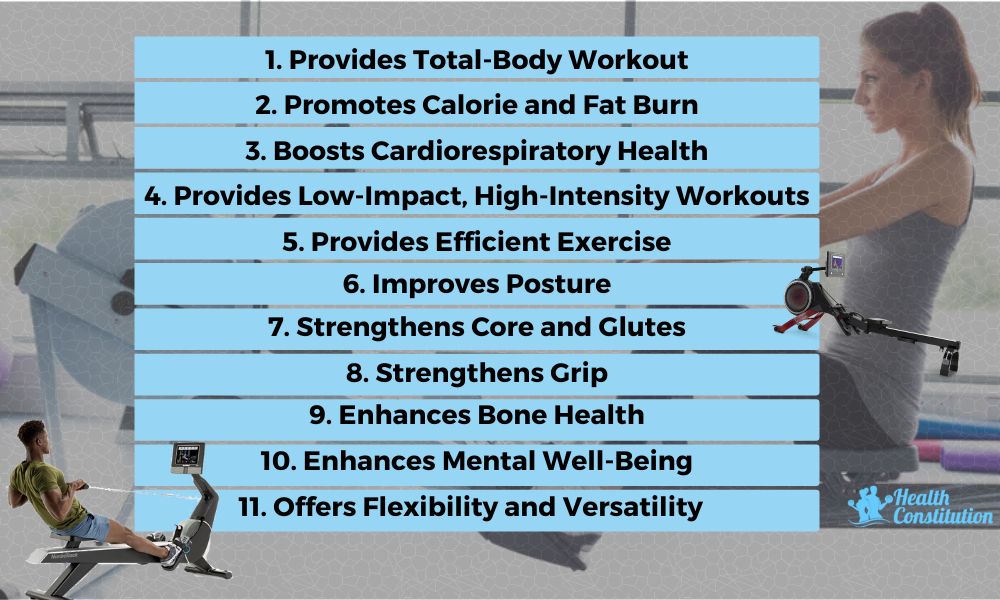
- 1. Provides Total-Body Workout
- 2. Promotes Calorie and Fat Burn
- 3. Boosts Cardiorespiratory Health
- 4. Provides Low-Impact, High-Intensity Workouts
- 5. Provides Efficient Exercise
- 6. Improves Posture
- 7. Strengthens Core and Glutes
- 8. Strengthens Grip
- 9. Enhances Bone Health
- 10. Enhances Mental Well-Being
- 11. Offers Flexibility and Versatility
- What Workouts Can You Do with a Rowing Machine?
- How Many Types of Rowing Machines Are There?
- How Do You Choose a Rowing Machine?
- What Does a Rowing Machine Do for Your Body?
1. Provides Total-Body Workout
Contrary to what some say, rowing is not solely an arm exercise. The American Fitness Professionals Association even noted that a rowing machine only works 25-35% of the upper body.
Most of the load goes to your legs. Specifically, you’re doing 65-75% lower-body workout for every completed rowing stroke.
That means rowing works out your upper and lower body while tapping over 80% of your muscles.
This rowing machine benefit explains why fitness experts say that this exercise is a unique combination of cardio and strength training.
The constant push-and-pull motion on the rower increases your heart rate and, in the process, burns calories.
On the other hand, the resistance from the machine flywheel makes your muscles work harder and exert more force, giving you that strengthening effect.
2. Promotes Calorie and Fat Burn
One of the advantages of getting the full-body workout effect from rowing is that you burn the optimum number of calories.
As you engage multiple muscles with every stroke, you also use more energy, increasing your oxygen needs. All these lead to the efficient burning of calories.
A report from Harvard Health Publishing shows that a 70-kg individual (155 lbs) can burn 252 calories after a 30-minute moderate rowing workout.
This calorie burn rate can increase to 369 calories when you shift to vigorous or intense rowing.
These values suggest that regular rowing combined with a healthy diet lets you meet the daily 500-calorie deficit requirement for healthy weight loss. Also, boosting your rowing intensity increases the calories you burn significantly.
But aside from calories, research shows that rowing is also good at torching body fat.
For instance, Astorino and colleagues (2021) noted that, compared with cycling, indoor rowing led to higher fat oxidation as this exercise uses more muscle mass.
A study with visually impaired participants also found that a 6-week rowing routine resulted in lower body fat percentage and cholesterol levels (Shin et al. 2015).
Without a doubt, heading straight for a rowing machine will benefit those who want to lose weight, reduce body fat, and improve their physique.
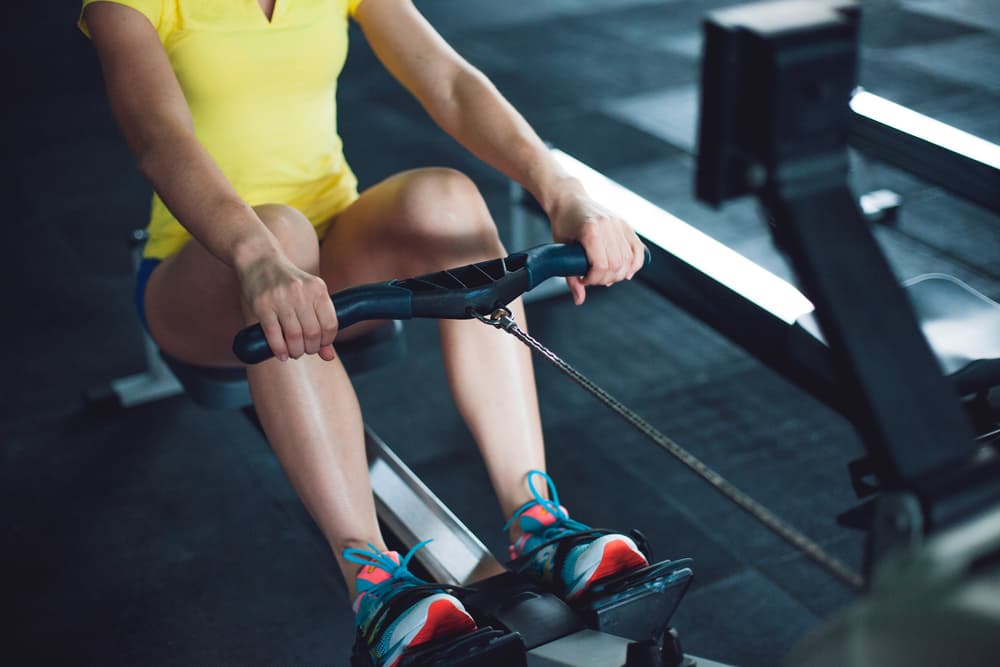
3. Boosts Cardiorespiratory Health
Cardio exercises, like indoor rowing, can strengthen your heart health. As you work out, your heart gets busy, increasing your circulation to transport oxygen and nutrients in time.
Your lungs also work as you inhale more oxygen during your rowing session.
Boosting the intensity of your cardio exercise makes your heart and lungs work harder, which, in turn, also heightens your body strength.
Hansen and colleagues (2023) support this. In their research, the participants demonstrated improved cardiorespiratory fitness after a 30-minute rowing exercise for 12 weeks.
In one article, NASM-certified personal trainer Caley Crawford explained that indoor rowing machines benefit the heart since the exercise uses plenty of muscles.
When you row and work more muscles, the heart has to double its efforts to supply more nutrients and oxygen. The result is a stronger heart that can endure regular or intense activities.
4. Provides Low-Impact, High-Intensity Workouts
Workout intensity plays a crucial role in our calorie burn rate. The more intense the workout, the more calories we burn.
But this fitness fact can be a problem with high-impact exercises.
Take treadmill running, for example. This cardio exercise burns plenty of calories, especially at a vigorous pace.
However, you also strain your leg muscles and joints as you run faster, putting your body at risk.
The effect is different with a rowing machine, though. There is no running or jumping in rowing, allowing you to row fast without straining your body too much.
This advantage benefits rowing machine users who prefer short but intense rowing sessions to lose weight, burn fat, or build stamina.
The low-impact nature of indoor rowers is also ideal for athletes, like runners and cyclists, who use their lower bodies for training and competitions.
But how joint-friendly is a rowing machine exactly? Well, one study showed that eight weeks of regular rowing improved the participants’ joints by 30% (Kang et al. 2014).
Researchers Higuchi and Asaka (2013) even concluded that seniors benefit from indoor rowers, particularly in preventing metabolic syndrome and sarcopenia or muscle loss.
You can learn more about the benefits of indoor rowing machines for seniors from this article.
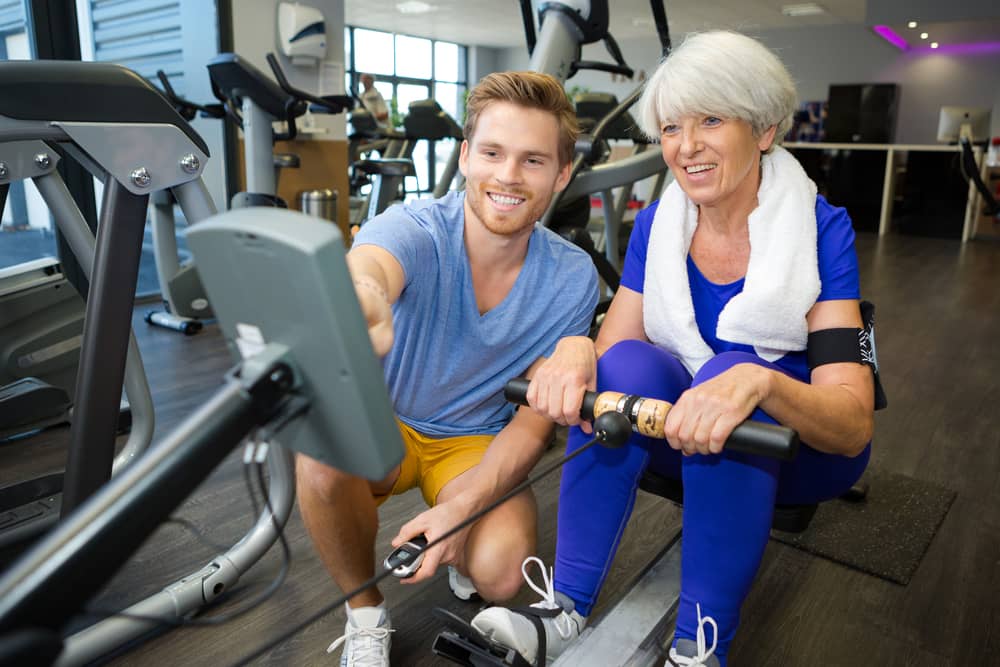
5. Provides Efficient Exercise
Several facts explain this benefit of a rowing machine. One is that indoor rowing is a full-body exercise.
With your upper and lower body moving simultaneously with each stroke, you move more muscles. And the more muscles you work, the more energy you consume.
That means you can efficiently burn calories even during short sessions.
Indoor rowing is also efficient because it allows high-intensity interval training or HIIT.
HIIT is a workout that involves intense rowing followed by active rest. And one study shows that even a HIIT session of fewer than 15 minutes results in multiple fitness improvements (Sabag et al., 2022).
So, if you want fitness results but are short on time, working out with an indoor rower is the way to go.
6. Improves Posture
As mentioned, working out on a rowing machine leads to fitness benefits like weight loss and increased muscle tone.
And both help in improving your overall physique and posture. A slimmer silhouette can make you look taller and feel more confident.
In addition, indoor rowing encourages you to stay focused and maintain your rowing form throughout your session. Otherwise, you’ll likely experience back pains post-workout.
And this is why researchers Neal and colleagues (2021) encourage health professionals, especially surgeons, to try ergometer rowing.
They explained that surgeons often work in poor ergonomic conditions that affect their posture, which leads to spinal pain.
With rowing exercises, surgeons can strengthen their core and postural muscles and alleviate work-related muscular stress.
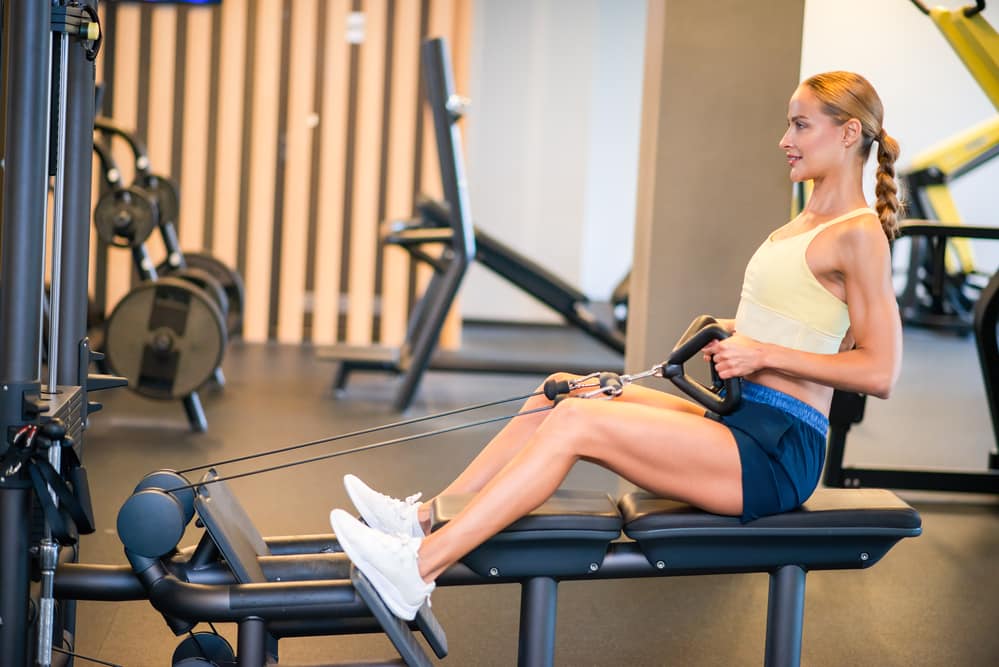
7. Strengthens Core and Glutes
Can I shape my butt or lose belly fat on a rowing machine? Yes, you can, and that’s because you burn calories every rowing session. So, having a consistent rowing routine helps you achieve that better-looking waist and bum.
But aside from burning calories and weight loss, rowing is excellent for your core muscles and glutes because of the constant push-and-pull motion.
Specifically, your glutes contract as you slide the rower seat forward and swing your body upright during the catch and drive phases.
On the other hand, you engage your core as you pull the rower handlebar close to your rib cage. At this stage, your abdominal muscles keep your upper body stable, so it can safely lean towards the back.
However, note that you have to master the proper rowing technique, so you can target the right muscle with each stroke and avoid post-workout pain.
8. Strengthens Grip
Grip strength is the force your hand can apply to an object. Some usual ways to enhance your grip are using a hand gripper and lifting weights.
And you can replicate the same hand-squeezing action by holding the oar or handlebar of your rower.
The pulling action of every rowing stroke can strengthen your hands and forearms, allowing you to move or lift things easily.
Younger adults may think this is only a minor rowing machine benefit, considering you can easily hold objects with or without exercise.
However, grip strength becomes crucial as we age. Older people are often less agile, making it harder to perform daily life activities.
One research even noted that grip strength is an essential indicator of good health among seniors (Bohannon 2019).
This finding only stresses that training for grip strength early will become useful later on.
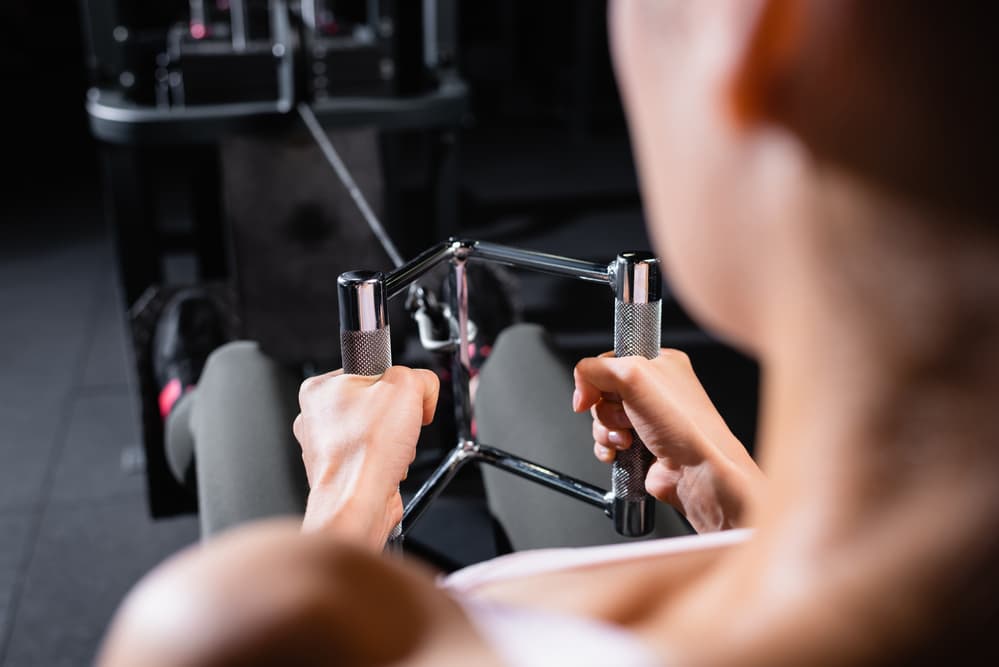
9. Enhances Bone Health
High-impact exercises like running are the best in stimulating bones to become bigger and stronger. But what if you prefer less strenuous workouts? Try indoor rowing instead.
I know that it is a low-impact activity. However, several studies concluded that rowing machine workouts have bone-building benefits.
For instance, a study in 2006 from Osteoarthritis and Cartilage assessed the level of bone absorption and cartilage stress among rowers, runners, swimmers, and sedentary individuals.
The findings showed that rowing led to significant bone reabsorption without cartilage stress, making it a balanced exercise for good bone health.
Another team of researchers also noted enhanced bone mineral density, particularly in the spine and hips, among athletes regularly performing rowing exercises (Śliwicka et al. 2015).
10. Enhances Mental Well-Being
This one is surprising, but studies show that a rowing machine benefits your mental health, too.
Any exercise promotes mental wellness primarily because it can stimulate a positive hormonal response.
Specifically, physical activities stimulate the release of happy hormones called endorphins. The role of these substances is to improve our mood and make us feel good.
In addition, exercise also suppresses cortisol or the stress hormone. So, it is no wonder why even small doses of exercise can lower our risk of depression (Pearce et al., 2022).
Rowing itself encourages a strong mind and body connection. Even if you do it indoors, the repetitive gliding motion brings the same Zen-like feeling you get with actual water rowing.
Elite rowers also shared that rowing helps them practice mindfulness and retain their focus.
As described in a 2014 study by Jordens and her team, rowers would apply strategies to count strokes to remain focused.
11. Offers Flexibility and Versatility
Rowing machine benefits are not only for active people or athletes. Anyone can do indoor rowing, no matter their fitness level.
As it is a low-impact exercise, older adults with joint issues can enjoy regular rowing workouts.
Depending on their capacity and doctor’s advice, they can adjust the exercise intensity, work at a lower resistance level, or shorten their rowing sessions.
Indoor rowing also suits beginners. Mastering the proper form may take some practice, though. Still, you don’t need to be in tip-top condition to get started.
Once you learn the basics, you should be able to row for extended periods or combine your rowing routine with your other favourite exercises.
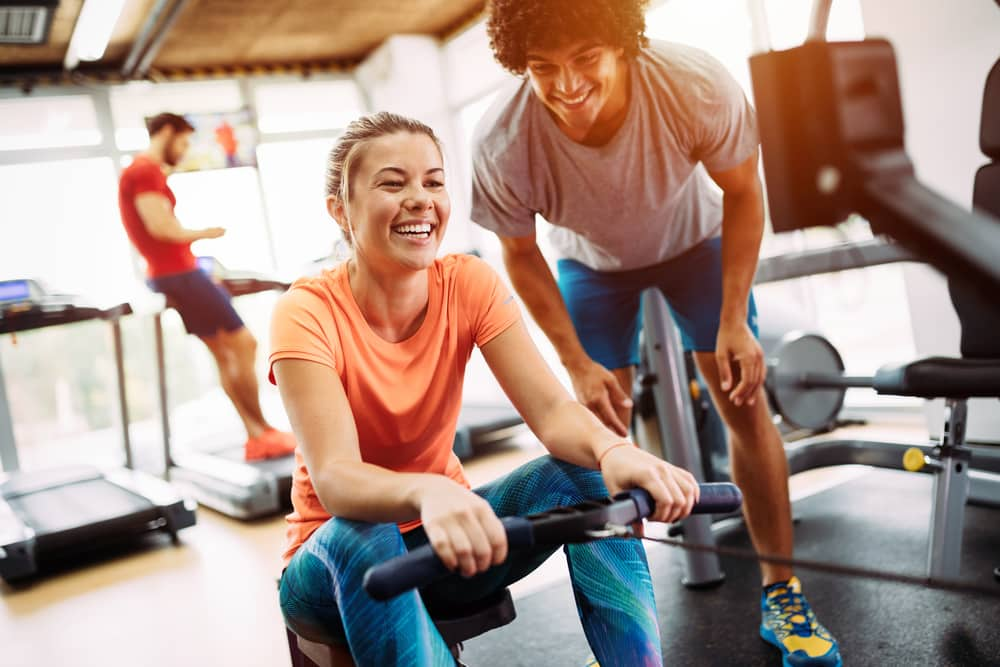
What Workouts Can You Do with a Rowing Machine?
I’ve mentioned that the versatility of a rowing machine is among its benefits. But aside from being compatible with any user type or fitness capacity, indoor rowers also encourage workout diversity.
You can try a different rowing session every day to counter boredom and fitness plateaus. Here are some examples.
Steady State
Steady-state rowing is a beginner-friendly exercise. Your focus here is to perform around 18 to 24 strokes per minute and maintain a 60-70% maximum heart rate.
Its duration depends on your fitness capacity. But as it is an easy-paced workout, you can do steady rowing for long periods, making it excellent for endurance training.
High-Intensity Interval Training (HIIT)
HIIT rowing workouts involve intense rowing strokes for a few seconds, followed by 1 to 2 minutes of active recovery. Usually, HIIT lasts no more than 30 minutes.
It’s an excellent training choice when you have little time for exercise or want to get optimum rowing machine benefits within shorter sessions.
Also, choose HIIT rowing to boost metabolism, burn fat, and preserve muscle mass. You can try a sample 20-minute HIIT rowing session from this article.
Tabata
Tabata is a HIIT type of workout done in 4 minutes. This strenuous but rewarding exercise is best for building power.
You can perform this on an indoor rower by doing eight rounds of 20-second intense rowing with 10 seconds of rest in between. Also, try doing the reverse Tabata workout by switching the work and rest times.
Pyramid
Pyramid rowing is another popular workout where you gradually increase your rowing intensity at predetermined phases. After the most intense rowing phase, you perform each stage again but in reverse.
Time, stroke count, and distance are crucial elements of a pyramid rowing workout.
For example, you can do a 4-minute first phase (at 22 strokes per minute), a 3-minute second phase (at 24 strokes per minute), and so on.
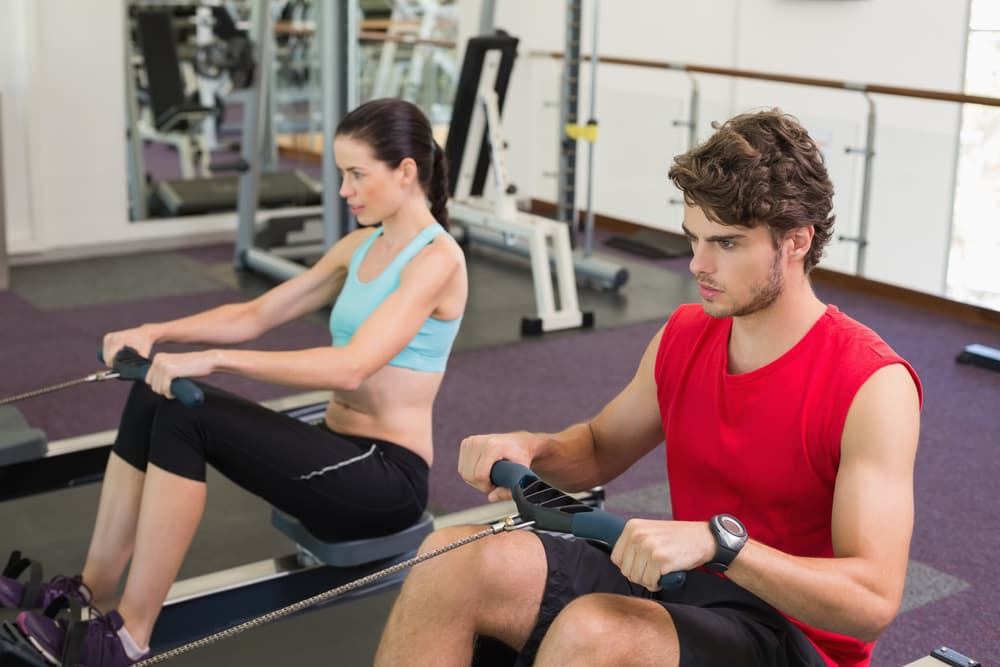
How Many Types of Rowing Machines Are There?
Rowing machines are categorised based on their resistance. And there are four types:
- Magnetic rowing machines have pre-set resistance levels that work with a magnetic system. The resistance range is often lower than other rowers, but this type is also low maintenance and quiet.
- Air rowing machines have fan blades to produce resistance. This type can be slightly noisy. But it also has infinite resistance levels that depend on your rowing intensity.
- Water rowing machines have a water tank that you need to fill so the paddles inside can produce resistance. Similar to air rowers, this type has infinite resistance levels. It also generates a relaxing sound that resembles outdoor rowing. However, water rowers are also the most expensive type.
- Hydraulic rowing machines are the most affordable and compact. This type has two hydraulic cylinders that use air or water to produce resistance. Its design is slightly outdated, and users may not find it very comfortable.
Each type of rowing machine has its benefits and downsides. But it should be easy to find the best rowing machine if you match its features with your specific needs and preferences.
Check out this article for a more in-depth comparison of these rowing machine types and their best user matches.
How Do You Choose a Rowing Machine?
Indoor rowers are investments. And knowing what product features to look for ensures that you get your money’s worth and reap rowing machine benefits for a long time.
So, aside from the resistance type discussed above, here are the other factors to consider.
Size
Indoor rowers are not small exercise machines. And some models can take up a lot of space. So, before buying, check your workout area and home gym, then designate a dedicated spot for your rowing machine.
Measure your selected area, and compare your measurements with the product dimensions of the rowing machine you plan to get.
It’s best to get a foldable unit if you are getting a rower for an apartment. Some models allow upright storage to save space, too.
Weight Capacity or Limit
Like most exercise machines, an indoor rower has a specified load limit. Most models have maximum user weights between 133kg and 159kg.
This feature is worth checking as it suggests machine durability and quality. It should also help users with a larger build find the right high-capacity rower they can safely use.
You can learn more about rowing machine weight limits here.
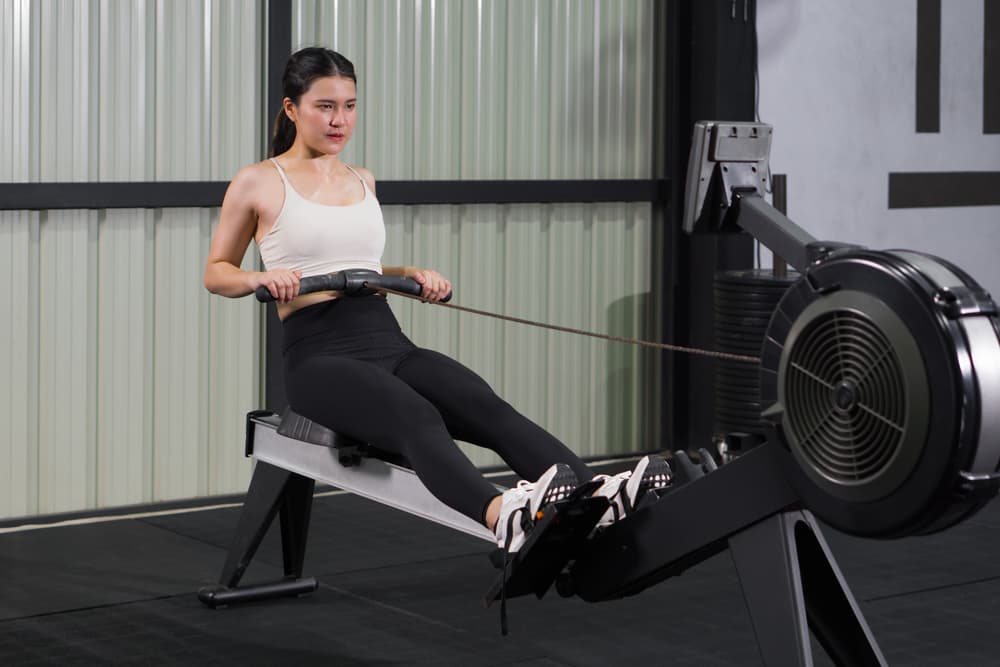
Noise Level
Rowing machines provide several health benefits, but they can also be noisy. And the noise level mainly depends on the flywheel and resistance type of the rower.
Some models, like the air resistance ones, are louder than others. Water rowers also produce water-sloshing sounds, which can be soothing for some.
If you want a quiet machine, you’ll have more options in the magnetic rower category. Test a few units as you shop around to check if they are too loud for your shared space or apartment.
Smart Features
Are you someone who needs extra motivation or some entertainment while working out? Do you enjoy rowing sessions better while watching movies, listening to music, or doing trainer-led classes?
If yes, then make sure to check the available add-ons of your indoor rower choices. These may include a built-in screen, pre-set workouts, Wi-Fi and Bluetooth connectivity, and app compatibility.
Some rowing machines also feature gaming modes, which are excellent if you enjoy racing or tournament-type workouts. But remember that the more add-ons a machine has, the more expensive it gets.
Cost
Rowing machines may be an investment, but you don’t have to spend a fortune to enjoy their benefits. There are budget, mid-range, and high-end models available.
But generally, a rowing machine between $1000 and $1900 should suit most fitness capacities and needs. You can check out this list of rowing machine price categories to learn more.
Aside from your budget, considering your lifestyle and preferences as a rowing machine owner is also essential.
For instance, are you a beginner, casual user, or athlete? Do you plan to use a rower exclusively or as a complement to other exercises?
The answers to these questions can help you determine whether a rowing machine is worth splurging on or a cheaper option will do.
Our best rowing machine page has reviews of high-quality indoor rowers for every budget. So, make sure to go and check it out as well.
What Does a Rowing Machine Do for Your Body?
A rowing machine benefits the body as it works your upper and lower body muscles. By engaging more muscles, you also strengthen your heart and lungs, burn calories, tone your body, and build stronger bones.
And thanks to its low-impact nature, you can do various types of rowing workouts without hurting your joints.
But aside from these fitness benefits, training with a rower gives you bonus benefits like better posture, improved grip, and a sound mind.
So, whether you want to lose weight, build endurance, or do something fun, a rowing machine got you covered.
- What Are the Advantages and Disadvantages of Folding Treadmills? - 11 March 2025
- Can You Use a Massage Gun When Pregnant? - 10 March 2025
- What is the Best Pre-Run Food? - 6 March 2025
